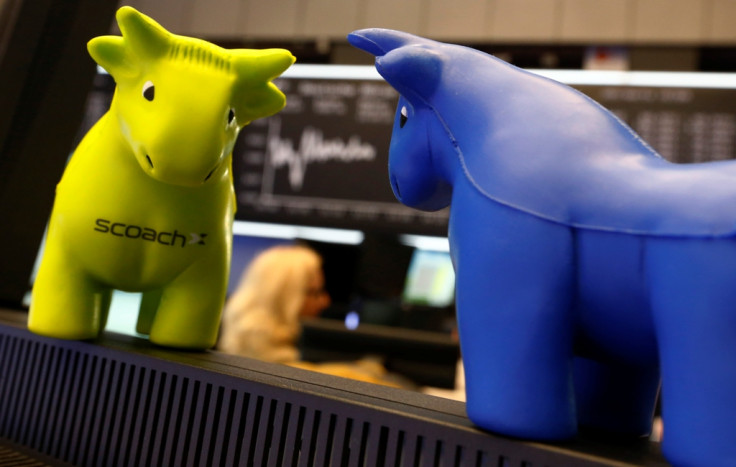European Markets Rise As Federal Reserve Taper Points to US Recovery

European markets opened higher on 19 December, and shot up thereafter, after the US Federal Reserve announced it would gradually unwind its historic stimulus.
The Stoxx Europe 600 index opened 0.6% higher to 315.90.
Britain's FTSE 100 opened 0.9% higher.
France's CAC 40 and Germany's DAX 30 opened 1.1% higher.
Spain's IBEX 35 was trading 1.99% higher after opening higher.
Italy's FTSE MIB was trading 1.27% higher after opening higher.
The Fed on 18 December announced it would trim its massive monthly bond buying stimulus, rolled out over a year ago to counter the impact of the global financial crisis and boost the American economy.
The world's most powerful central bank said it would scale back its $85bn (£51.8bn, €61.8bn) a month asset buying programme by $10bn a month starting January 2014.
Specifically, the Fed would reduce its US Treasury purchases from $45bn to $40bn a month; and its mortgage-backed securities (MBS) purchases from $40bn to $35bn a month.
The Federal Open Market Committee (FOMC), the Fed's governing body, cited strong job growth in the US as the reason behind its decision.
The Fed also sought to calm the markets by saying its key interest rate would remain near zero "well past the time" the American unemployment rate drops below 6.5%.
Standard Chartered said in a note to clients: "[Fed] Chairman Bernanke hinted that further reductions of USD 10bn would continue at subsequent meetings, signalling that the FOMC looks determined to bring QE to an end within eight or nine FOMC meetings."
"Bernanke highlighted that tapering is not on a pre-set course, but in practice, we think the Fed is unlikely to be distracted by the data unless the economy weakens considerably - which we do not expect. We see bond-buying ending in October 2014 after cuts of USD 10bn at each meeting."
Standard Chartered said in a separate note: "The Fed will now focus on using its forward guidance to signal its first rate hike. At previous meetings Bernanke highlighted that there might be considerable time between the end of QE and the first rate hike."
"Still, the FOMC has now gone a step further by more explicitly tying the first rate hike to medium-term inflation expectations breaching 2%. This dilutes the 6.5% unemployment goalpost, which is left unchanged."
"But this also indicates that further heavy lifting on improving the forward guidance is left to incoming Fed President Janet Yellen. An underlying message is that the Fed is keen on maintaining some discretion in its monetary policy," the British bank added.
Market participants in the UK will be tracking November's retail sales data, due out at 09:30GMT.
Elsewhere, market players will be following developments in Brussels, where a two-day summit of European leaders, beginning 19 December, is hoped to provide a setting to cement the historic banking union deal.
So far, it has been agreed that banks will be charged a levy of about €55bn (£46.5bn, $76bn) over the next 10 years. That would accumulate into the so-called Single Resolution Fund.
If there is not enough money in the pot, national governments could supply funds, or bolster contributions from the European Stability Mechanism (ESM), which is the eurozone bailout fund.
In Asia
The Japanese Nikkei finished 1.74% on 19 December. Australia's S&P/ASX finished 2.08% higher and South Korea's Kospi finished 0.05% higher.
However, the Shanghai Composite finished 0.95% lower.
Markets witnessed mixed trade, with the Nikkei finishing at a six-year high, after the Fed announcement.
However, the Fed decision weighed down on Asian currencies. The Japanese yen dropped to a near five-year low against the US dollar while Indonesia's rupiah dropped to a five-year low.
The Malaysian ringgit and the Philippine peso dropped to three-month lows, while the Indian rupee logged modest losses.
In Japan, the country's central bank kicked off a two-day policy meeting on 19 December.
Elsewhere, in China, the benchmark Shanghai Composite index finished at a one-month low after the seven-day repo-rate struck its highest level since June for a second consecutive session.
India's Finance Minister P Chidambaram said in a statement: "[The Indian] government is of the view that the [Indian] markets had already factored in the US Federal Reserve's decision and therefore is not likely to be surprised by these moderate changes."
On Wall Street
On Wall Street, indices closed at record highs on 18 December on the back of the Fed decision.
The Dow finished 292.71 points, or 1.8%, higher at 16,167.97, topping its 27 November record.
The S&P 500ended 29.65 points, or 1.7%, higher at 1,810.65, a record finish for the index.
The tech-heavy Nasdaq closed 46.38 points, or 1.2%, higher at 4,070.06, finishing at a 13-year high.
Meanwhile, the US Senate passed the two-year Ryan-Murray budget deal to ease automatic spending cuts and reduce the risk of another federal shutdown. The focus now shifts to a spending measure that Congress must pass by 15 January, 2014.
"Investors are looking past the taper and looking at the strength of the economy that is perceived with this news," said Chris Gaffney, senior market strategist at EverBank.
"The Fed did a great job telegraphing it to the markets, as stocks are moving in the opposite direction than you'd think," he told CNBC.
© Copyright IBTimes 2025. All rights reserved.






















